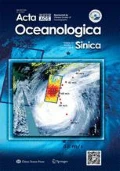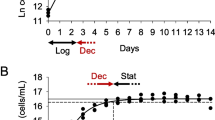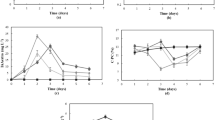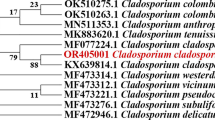Abstract
Allelopathic effects of several concentrations of fresh tissue, dry powder and dry tissue of three bloom-forming green macroalgae Ulva pertusa, Ulva linza and Enteromopha intestinalis on the red tide microalga Heterosigma akashiwo were evaluated in microcosms systems. The effects of macroalgae culture medium filtrate were investigated on H. akashiwo using initial or semi-continuous filtrate addition. Preliminary studies on the algicidal effects of one aqueous and four organic solvent extracts from the macroalgae on the microalga were carried out to confirm the existence of allelochemicals in the tissue of these macroalgae. The dry powder of U. pertusa was extracted with methanol, and the methanol extracts were partitioned to petroleum ether phase, ethyl acetate phase, butanol phase and distilled phase by liquid-liquid fractionation. The bioassays of the activity of every fraction were carried out on H. akashiwo. The resultant microcosms assay showed that the growth of H. akashiwo was strongly inhibited by using fresh tissues, dry powder or dry tissue of these three macroalgae, while aqueous and methanol extracts of both macroalgae had strong inhibitory effects on the growth of H. akashiwo, and the EC50 values for methanol extract of U. pertusa, U. linza or E. intestinalis were 0.016, 0.028×10−12 or 0.033×10−12, respectively. While the other three organic solvent extracts (acetone, ether and chloroform) had no apparent effect on its growth, this suggests that the allelochemicals from these three macroalgae had relatively high polarities. The activity of petroleum ether phase, ethyl acetate phase, butanol phase and distilled phase of U. pertusa methanol extract was carried out on H. akashiwo indicating that petroleum ether phase and ethyl acetate phase had stronger algicidal effect on H. akashiwo. The inhibition effect of the ethyl acetate phase was not as strong as that of petroleum ether phase, and effective concentration of petroleum ether phase was 17 mg/L for H. akashiwo. However, no significant algicidal effects were observed on the butanol phase and distilled water phase. These three macroalgae’s culture medium filtrate exhibited no apparent growth inhibitory effect on the microalga under initial filtrate addition whereas the growth of H. akashiwo was significantly inhibited under semi-continuous filtrate addition, which suggests that continuous release of small quantities of rapidly degradable allelochemicals from the fresh tissue of both macroalgae was effective in inhibiting the growth of H. akashiwo.
Similar content being viewed by others
References
Alamsjah M A, Hirao S, Ishibashi F, et al. 2007. Algicidal activity of polyunsaturated fatty acids derived from Ulva fasciata and U. pertusa (Ulvaceae, Chlorophyta) on phytoplankton. Journal of Appied Phycology, 20: 263–270
Ding Lanping, Fei Xiugeng, Lu Qinqin, et al. 2009. The possibility analysis ofhabitats, origin and reappearance of bloom green alga (Enteromorpha prolifera) on inshore of western Yellow Sea. Chinese Journal of Oceanology and Limnology, 27: 421–424
Fong P, Donohoe R M, Zedler J B. 1993. Competition with macroalgae and benthic cyanobacterial mats limits phytoplankton abundance in experimental microcosms. Marine Ecology Progress Series, 100: 97–102
Guillard R R L. 1975. Culture of phytoplankton for feeding marine invertebrates. In: Smith W L, Chanley M H, eds. Culture of Marine Animals. New York: Plenum Press, 26–60
Han M S, Kim Y P, Cattolico R A. 2002. Heterosigma akashiwo (Raphidophyceae) resting cell formation in batch culture: Antibiotic production by the cyanobacteria Oscillatoria angustissima and Calothrix parietina. Environental Toxicology and Pharmacology, 8: 33–37
Jeong J H, Jin H J, Sohn C H, et al. 2000. Algicidal activity of the seaweed Corallina pilulifera against red tide microalgae. Journal of Appied Phycology, 12: 37–43
Jiang Peng, Wang Jinfeng, Cui Yulin, et al. 2008. Molecularphylogenetic analysis of attached Ulvaceae species and free-floating Enteromorpha from Qingdao coasts in 2007. Chinese Journal of Oceanology and Limnology, 26: 276–279
Jin Qiu, Dong Shuanglin. 2003. Compratitive studies on the allelopathic effects of two different strains of Ulva pertusa on Heterosigma akashiwo and Alexanadrium tamarense. Journal of Experimental Marine Biology and Ecology, 293: 41–45
Jin Qiu, Dong Shuanglin, Wang Changyun. 2005. Allelopathic growth inhibition of Prorocentrum micans (Dinophyta) by Ulva pertusa and Ulva linza (Chlorophyta) in laboratory cultures. European Journal of Phycology, 40: 32–37
Kukisawa H, Asari F, Kusumi T, et al. 1988. An allelopathic fatty acid from the brown alga Aladosiphon okaamuranus. Phytochemistry, 27: 731–735
Nagayama K, Shibata T, Fujimoto K, et al. 2003. Algicidal effect of phlorotannins from the brown alga Ecklonia kurome on red tide microalgae. Aquaculture, 218: 601–611
Nakai S, Inoue Y, Hosomi M, et al. 1999. Growth inhibition of blue-green algae by allelopathic effects of macrophytes. Water Science Technology, 39: 47–53
Nelson T A, Lee D. 2001. A manipulative experiment demonstrates that blooms of the macroalga Ulvaria obscura can reduce eelgrass shoot density. Aquatic Botany, 71: 149–154
Nelson T A, Lee D, Smith B C, et al. 2003. Are “green tides” harmful algal blooms? Allelopathic properties of extracts from Ulva fenestrata and Ulvaria obscura. Journal of Phycology, 39: 874–879
Oh M Y, Lee S B, Jin D H, et al. 2010. Isolation and algicidal compounds from the red alga Corallina Pilulifera against red tide microalgae. Journal of Appied Phycology, 22: 453–458
Shumway S. 1990. A review of the effects of algal blooms on shellfish and aquaculture. J World Aquac Soc, 21: 65–104
Suzuki M, Wakana I, Denboh T, et al. 1996. An allelopathic polyunsaturated fatty acid from red algae. Phytochemistry, 43: 63–65
Taylor R, Fletcher R L, Raven J A. 2001. Preliminary studies on the growth of selected ‘green tide’ algae in laboratory culture: effects of irradiance, temperature, salinity and nutrients on growth rate. Bot Mar, 44: 327–336
Van Alstyne K L, Nelson A V, Vyvyan J R, et al. 2006. Dopamine functions as an antiherbivore defense in the temperature green alga Ulvaria obscura. Oecologia, 148: 304–311
Van Alstyne K L, Wolfe G V, Freidenburg T L, et al. 2001. Activated defense systems in marine macroalgae: evidence for an ecological role for DMSP cleavage. Mar Ecol Prog Ser, 213: 53–65
Van Donk E, Van de Bund W J. 2002. Impact of submerged macrophytes including charophytes on phyto-and zooplankton communities: allelopathy versus other mechanisms. Aquatic Botany, 72: 261–274
Wang Renjun, Xiao Hui, Wang You, et al. 2007. Effects of three macroalgae, Ulva linza (Chlorophyta), Corallina pilulifera (Rhodophyta) and Sargassum thunbergii (Phaeophyta) on the growth of the red tide microalga Prorocentrum donghaiense under Laboratory conditions. Journal of Sea Research, 58: 189–197
Yang B J, Zheng L, Chen J H, et al. 2009. Cluster analysis on fatty acid compositionof Enteromorpha prolifera off northern China coast. Oceano Limnol Sin, 40(5): 627–632
Zhao Yan, Yu Qingyun, Zhou Bin, et al. 2009. Allelopathic effect of Corallina pilulifera on Heterosigma akashiwo and its responses to UV-B irradiation. Chinese Journal of Applied Ecology (in Chinese), 20: 2558–2562
Author information
Authors and Affiliations
Corresponding author
Additional information
Foundation item: The National Natural Science Foundation of China under contract No. 31070458; the National Key Technology Support Program under contract No. 2010BAC68B00; the Natural Science Foundation of Shandong Province under contract No. 2009ZRB01461; the Encouraging Foundation for Outstanding Youth Scientists of China under contract No. 2008BS09011; the Science and Technology Project of Institutions of Higher Education of Shandong under contract No. J10LC13; Special Grade of the Financial support from China Postdoctoral Science Foundation under contract No. 201003652; Financial support from China Postdoctoral Science Foundation under contract No. 20090451350.
Rights and permissions
About this article
Cite this article
Wang, R., Feng, L., Tang, X. et al. Allelopathic growth inhibition of Heterosigma akashiwo by the three Ulva spcieces (Ulva Pertusa, Ulva Linza, Enteromorpha intestinalis) under laboratory conditions. Acta Oceanol. Sin. 31, 138–144 (2012). https://doi.org/10.1007/s13131-012-0214-z
Received:
Accepted:
Published:
Issue Date:
DOI: https://doi.org/10.1007/s13131-012-0214-z




